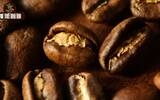How to use the coffee colorimeter? What do you think of the degree of roasting of coffee beans? What do the powder value, color value, and RD value of coffee mean?
When we observe a coffee bean, we will not only identify its variety and treatment by its appearance characteristics, but also make a preliminary judgment on its baking degree according to its appearance color. The darker the coffee beans are, the deeper the coffee beans are roasted; the lighter the coffee beans are, the lighter the coffee beans are.
However, visual observation is obviously not scientific enough, and it is easy to make differences in communication. So within the industry, people will measure the caramelization degree of coffee beans in a scientific way, which can be used as a reference for baking.
What is the caramelization degree value?
Caramelization degree value-"Agtron Number", referred to as Agtron value and color value in the industry. In the process of baking, "Maillard reaction" and "caramelization reaction" are the two main chemical reactions of coffee bean flavor substances. In addition to generating more flavor to the coffee beans, they can also increase the color depth of the coffee beans. As I said at the beginning, the deeper the baking, the darker the color. The measurement of color value is to use a specific instrument (coffee bean roasting colorimeter) to measure the color depth of coffee beans, in order to define the degree of roasting.
The principle of measurement is easy to understand: it is the use of the carbonized substances of coffee beans to absorb infrared light! The specific operation is: the instrument will emit infrared light to illuminate the coffee beans, and if the infrared ray comes into contact with the carbonized substance, it will be absorbed, and the infrared light reflected back will be reduced. Then the machine will calculate the value according to the degree of light refracted back, and finally we will divide the degree of baking by the size of the value.
The deeper the roast, the more carbonized the beans, the more infrared light they absorb, the less light they refract, resulting in fewer values, and vice versa. Then people made an Agtron value baking table based on this number, which is the one often shared by Qianjie.
Then I believe you have heard the word "powder value" in the industry, which is also easy to understand, that is, the color value of coffee powder: the final value obtained by grinding coffee beans into powder and then measuring them with an instrument. Since the overall heating degree of coffee beans varies (or consistent) depending on the way they are roasted, the color value obtained by measuring the coffee powder will be an average of the roasting degree of the whole coffee bean.
Then what we need to know is that the real purpose of measuring the color values of the two is to calculate the "Roast Delta" (baking difference), or Rd value, from the color values of beans and powder. It is not to define the roasting degree of coffee beans (not the main purpose), because this method has some disadvantages, so the value can only be used as a reference.
There are two reasons: the first is that in addition to carbonized substances, Maillard reaction and caramelization will also produce melanin, menadine and other substances that absorb infrared light during baking, which cannot be distinguished by the instrument. so they all affect the final value.
The second is that under different treatments, the appearance of coffee beans will be different due to the different sugar content in the roasting process. Take the anaerobic and honey-treated coffee beans as an example, these coffee beans will continue to be soaked in pectin, fruit juice and other substances in the process of treatment, resulting in sugar attached to the bean surface of the coffee beans.
As a result, they are subjected to a deeper caramelization reaction than other treated coffee beans, resulting in a darker surface color. Although the taste is sweet and sour light roasted coffee, but the color of the bean surface is close to the dark roasted coffee black. Therefore, the treatment method will also make a difference in the final measured results.
So what is the RD value?
RD value is the difference between bean color value and powder value, which is mainly used to measure whether the internal and external baking degree of coffee beans is consistent during the baking process. The formula is that the value is high minus the value is low. For example, if the color value of coffee beans is 61 and the color value of coffee powder is 71, then the calculation formula is 71-61. The result is that the difference between the two is 10, that is, the R D value is 10.
When the difference number is smaller, it means that the degree of baking inside and outside the bean is more uniform, and it will be more balanced in taste, while the larger the difference number, the greater the difference between the baking degree inside and outside the bean. An appropriate amount of gap helps to reflect the level, while a high gap means that the baking method may need to be adjusted. In addition to the differences in treatment methods, it may also be because the bean surface is overheated, resulting in caramelization reaction that far exceeds the internal baking of the bean, so the difference between the powder value and the color value of the bean is too high.
Of course, the use of RD values is not limited to that. Here is just a brief introduction to the role and meaning of each value, if you expand to talk about it, it will become a long story. So save Qianjie for next time, and another article will introduce in detail how to use them.
-END-
Important Notice :
前街咖啡 FrontStreet Coffee has moved to new addredd:
FrontStreet Coffee Address: 315,Donghua East Road,GuangZhou
Tel:020 38364473
- Prev

What should I make quicksand ice American? How much water and ice do you need for ice American? Three different American making of quicksand ice to share!
Sure enough, the beginning of winter in Guangdong is a process. After a few days of cooling, it returns to the hot "dog days", so the sales of iced coffee have not been affected at all. As a popular summer product in cafes, Ice-American products are also popular. Especially since Qianjie has shared it many times
- Next

What's the difference between sun-drying and washed coffee? How to distinguish sun-dried beans from washed beans? Detailed explanation of the sun and washing treatment process!
"Washed" and "Natural" are the two most traditional and widely used treatments in coffee. The so-called treatment is a process in which harvested fruits are scraped to remove all substances except coffee beans and dried to a specified degree. Live here
Related
- Being chased out of the rain in front of Starbucks?! Store: Sheltering from rain under umbrellas poses a safety hazard
- The white moonlight has changed?! Lucky launches "Big Winter Pear American"
- Hand-brewed coffee three-stage method, high-sweet and universal brewing method to share! What does the high sweet water level of hand-brewed coffee mean?
- What is the difference between raw, refined and full espresso coffee? How to extract espresso and taste good?
- A complete list of coffee bean names and their meanings! What is Yejia Shefi coffee? Where is Mantelin coffee?
- What grade does Arida Manor Kaduai coffee beans belong to? What treatment is Arida ASD slow anaerobic sun exposure?
- The milk tea cup becomes smaller?! Overlord Tea Girl launches a new "Return to Yunnan" series
- Accused of selling counterfeit and high-priced coffee beans! Well-known boutique coffee brand "Oukelao" bowed and apologized!
- How to make espresso dumplings? Can I eat coffee and glutinous rice balls together?
- Save the unformed and stagnant powder cakes in one second! What is the problem with stagnant water in the powder bowl of the espresso machine?

